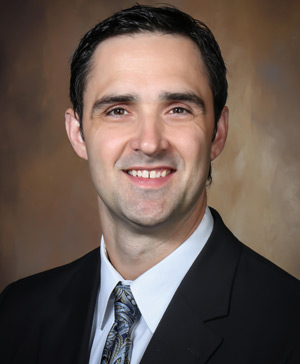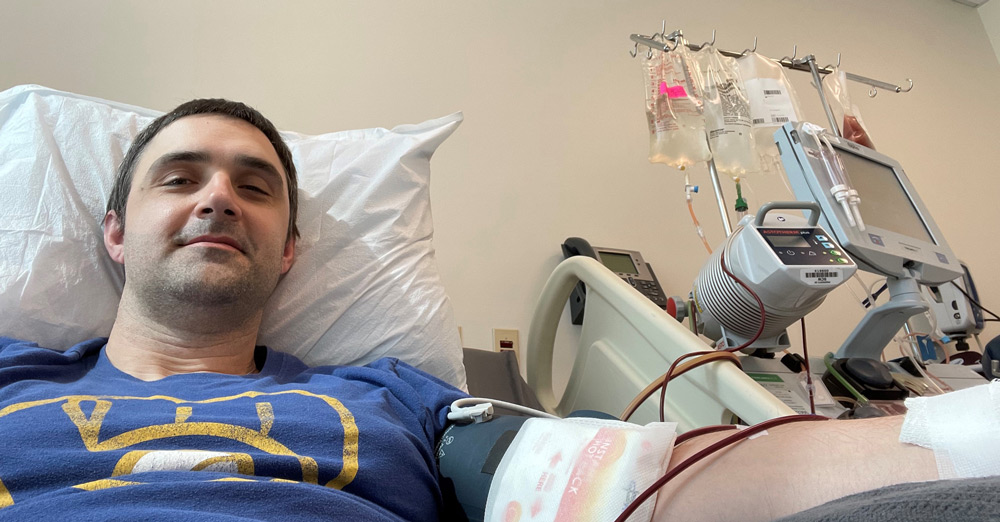Bone Marrow Donation: A Lifesaving Second Chance
CentraCare Orthopedic Trauma Surgeon Robert Jacobs, MD, was in medical school when he made a quick decision that would eventually lead him on a journey to change one stranger’s life forever.
He signed up to be a bone marrow donor with Be the Match when he was in college. “There was a drive … outside of one of our major lectures … we had a really large class and a bunch of young healthy people.”
It was the perfect location to search for matches. With a simple swab of his cheek, Dr. Jacobs’ information was saved in a donor bank of potential candidates. Bone marrow donations are often used to help people in need of a transplant who are suffering from leukemia and lymphoma.
 “We were going to school to be doctors to help people. I mean, this is an extension of that same sort of commitment,” said Dr. Jacobs.
“We were going to school to be doctors to help people. I mean, this is an extension of that same sort of commitment,” said Dr. Jacobs.
He was contacted nearly a year later and told he might be a match for somebody. As it turned out, someone else had been a closer match based on certain major and minor donor criteria. Little did Dr. Jacobs know it would be more than 10 years before he’d have a chance to save the life of a 49-year-old woman.
“This past December, I was running my orthopedic clinic and I got a text from some random number. I ignored it because I thought it was spam,” Dr. Jacobs confessed.
He had forgotten about signing up for bone marrow donation nearly a decade prior. Luckily, Be the Match didn’t stop there. “They text you, they call your phone, they’re persistent,” laughed Dr. Jacobs.
Those calls ended up going straight to voicemail. Dr. Jacobs read the transcript of the message and realized it was Be the Match Foundation, promising it wasn’t a fake call.
He was just about to see his next patient when his nurse came walking down the hall to let him know someone was on the phone for him and it was urgent.
The doctor was in disbelief, “How the heck did they get ahold of me? Because the address I had on file was my apartment when I was in medical school and now, they’re calling me on a clinic phone. I’ve gone through … residency and fellowship, and now I’m in practice. I’ve moved like … eight times over the course of that career.”
Dr. Jacobs decided to go forward with the donation. He underwent several interviews and rounds of questioning to make sure he was the right fit, “these people that you’re going to be donating to have such compromised immune systems…anything can just knock them out.”
He is a higher-risk donor because he is an orthopedic surgeon.
They took a blood draw and sent the doctor on his way. It was another two months before he was contacted again and told he was the best match.
That was just the beginning of his journey. Next, he’d find himself getting a special physical so they could do vein mapping and figure out if his veins would be able to tolerate the size needle needed for the procedure.
Since he is a doctor, he was able to self-administer shots to increase his white blood cell count. “I gave three injections into my belly or into my arm.”
Dr. Jacobs had to repeat that process three times a day for four days, “Those shots weren’t bad the first day … what I experienced was fatigue, muscle aches, body aches, a little bit of a headache, but nothing that I couldn’t get through with a little bit of Tylenol and ibuprofen.”
At this point, the timing was everything. Doctors needed to be able to synch up Jacobs’ donation with the oncology team that was going to be administering chemotherapy to the person receiving the bone marrow donation
Be The Match put Dr. Jacobs on a plane from Minneapolis to Milwaukee and covered his transportation, hotel, meals and lost wages — and would have covered a nanny for his children if he needed it. They also offer to cover the costs of airfare and hotel for another person to travel with the donor.
“They pull out all the stops to make sure that they can get somebody who is a non-family member donor because you’re kind of doing it out of the goodness of your heart to some degree,” Dr. Jacobs explained.
On donation day, nurses took a blood draw to measure his white blood count, “It was crazy high. As a physician, you’d only ever see a white count as high as mine was in somebody who actually had cancer or leukemia. That’s how well the drug works.”
Dr. Jacobs was hooked up to a machine that could pull out his blood and separate it into different layers to extract the white blood cells. The rest of his blood was put back into his body. The procedure is a lot less invasive than many people think.
“The amount they ran for me was 17 or 18 liters of blood. They ran my entire blood volume through at least three times to pull out the necessary stem cells,” Dr. Jacobs recalled.
The whole process took approximately eight hours, including the six hours spent sitting in the donation chair. He reported being fully recovered in four or five days.
“You just feel kind of tired and achy and then every single day got better,” Dr. Jacobs remembered.
He doesn’t know the name of the person he helped save. He knows she was a 49-year-old female from the United States diagnosed with acute myeloid leukemia (AML).
“That kind of hit home with me because I have a very good friend and colleague who was similar in age, and she needed to do a bone marrow transplant as well.”
Dr. Jacobs isn’t new to saving lives. As an orthopedic surgeon, he is used to putting people back together, “Maybe I was a bit desensitized to that…then afterward… it was a lot more personal …because it wasn’t just my time or my training. It was like giving myself to somebody else.”
After the donation, Be the Match sent him a booklet of stories that former donation recipients had submitted. Dr. Jacobs was also informed that he’ll have the opportunity to meet the person he helped save someday if he wants to.
“I could choose not to, but I think…after reading some of those stories and seeing how much it means to those people … it is definitely a whole part of the process and something I think is going to be good.”
If he had the chance to do it all over again, he says he would, “You have the opportunity to save somebody’s life … it is something that is incredibly memorable and positive…and a powerful experience that is definitely worthwhile.”
